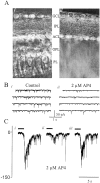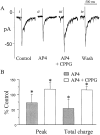Intensity-dependent, rapid activation of presynaptic metabotropic glutamate receptors at a central synapse
- PMID: 11160453
- PMCID: PMC6763806
- DOI: 10.1523/JNEUROSCI.21-02-00741.2001
Intensity-dependent, rapid activation of presynaptic metabotropic glutamate receptors at a central synapse
Abstract
Synaptic signals from retinal bipolar cells were monitored by measuring EPSCs in ganglion cells voltage-clamped at -70 mV. Spontaneous EPSCs were strongly suppressed by l-2-amino-4-phosphonobutyrate (AP-4), an agonist at group III metabotropic glutamate receptors (mGluRs). Agonists of group I or II mGluRs were ineffective. AP-4 also suppressed ganglion cell EPSCs evoked by bipolar cell stimulation using potassium puffs, sucrose puffs, or zaps of current (0.5-1 microA). In addition, AP-4 suppressed Off EPSCs evoked by dim-light stimuli. This indicates that group III mGluRs mediate a direct suppression of bipolar cell transmitter release. An mGluR antagonist, (RS)-alpha-cyclopropyl-4-phosphonophenylyglycine (CPPG), blocked the action of AP-4. When bipolar cells were weakly stimulated, AP-4 produced a large suppression of the EPSC, but CPPG alone had little effect. Conversely, when bipolar cells were strongly stimulated, CPPG produced an enhancement of the EPSC, but AP-4 alone had little effect. This indicates that endogenous feedback regulates bipolar cell transmitter release and that the dynamic range of the presynaptic metabotropic autoreceptor is similar to that of the postsynaptic ionotropic receptor. Furthermore, the feedback is rapid and intensity-dependent. Hence, concomitant activation of presynaptic and postsynaptic glutamate receptors shapes the responses of ganglion cells.
Figures









References
-
- Anwyl R. Metabotropic glutamate receptors: electrophysiological properties and role in plasticity. Brain Res Brain Res Rev. 1999;29:83–120. - PubMed
-
- Arkin MS, Miller RF. Subtle actions of 2-amino-4-phosphonobutyrate (APB) on the Off pathway in the mudpuppy retina. Brain Res. 1987;426:142–148. - PubMed
-
- Asztely F, Erdemli G, Kullmann DM. Extrasynaptic glutamate spillover in the hippocampus: dependence on temperature and the role of active glutamate uptake. Neuron. 1997;18:281–293. - PubMed
Publication types
MeSH terms
Substances
Grants and funding
LinkOut - more resources
Full Text Sources
